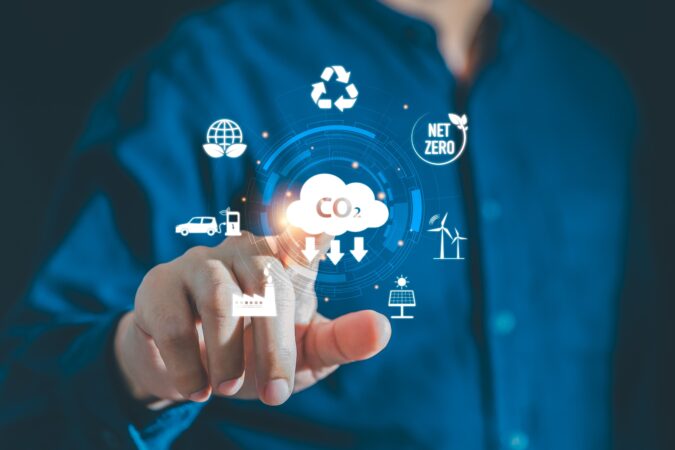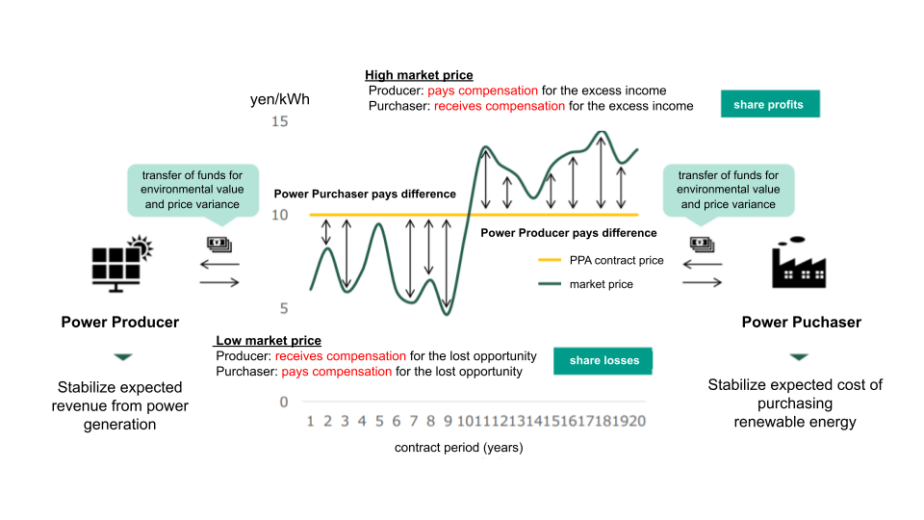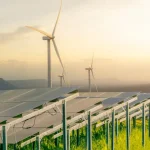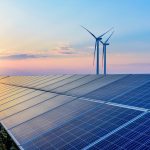What is Off-site PPA? Explaining the Mechanism, Corporate Benefits, and Government Subsidies
Have you heard about off-site PPAs, an increasingly popular model for integrating renewable energy? Off-site PPA is a type of corporate PPA where a PPA provider installs renewable energy sources at a location separate from the electricity consumer’s facilities, such as a company or municipality. The generated power is then delivered to the consumer via the electricity grid, often times by an electricity retailer.
Understanding PPAs can be complex, so this article aims to provide a clear and comprehensive overview, covering everything from the basics of PPAs to the specifics of off-site PPA mechanisms, cost structures, and government subsidies.

目次
- What is Off-site PPA?
- Definition of Off-site PPA:
- Types of Off-site PPA
- What is On-site PPA?
- Advantages and Challenges of Off-site PPAs
- Government Support for Off-site PPAs
- Shizen Energy’s Off-site PPA Contract with Google
- Summary
What is Off-site PPA?
In an off-site PPA, a power producer installs power generation facilities away from the location where the electricity will be used. The generated electricity is then supplied to the consumer through the electrical grid, which is managed by an electricity transmission and distribution utility.
Let’s start with the basics: What exactly is a PPA?
PPA stands for “Power Purchase Agreement.” In Japan, it’s often referred to as the “PPA model.” Essentially, a PPA allows an electricity consumer to directly choose a power plant and purchase electricity from it. This mechanism is particularly valuable for reliably sourcing renewable energy, and it’s why the PPA market has been expanding significantly and gaining considerable attention.
Corporate PPA
A Corporate PPA is a long-term contract, typically spanning 10 to 25 years, where a company or municipality agrees to purchase renewable energy directly from a power producer. This model allows organizations to procure renewable energy without the upfront costs of installing their own renewable energy infrastructure. There are two main types of Corporate PPAs: off-site PPAs and on-site PPAs.
Definition of Off-site PPA:
- A renewable energy power producer and an electricity consumer enter into a Power Purchase Agreement, establishing a pre-agreed price and contract duration for renewable energy.
- The renewable energy generated by a power source located away from the consumer’s site is supplied through the grid, which is managed by an electricity transmission and distribution utility.
- It’s important to note that definitions and interpretations of off-site PPAs can vary depending on the specific country and its regulatory framework.
| Reduce Your Scope 2 Emissions Globally with Shizen Energy’s Off-site PPA Solutions. We offer effective off-site PPA to help businesses achieve their sustainability goals in Japan and internationally. |
Types of Off-site PPA
There are two types of off-site PPA:
- Physical PPA
- Virtual PPA
Physical PPA
In a Physical PPA, a direct agreement is established between a renewable energy power producer and an electricity purchaser for the sale and purchase of renewable energy. The purchaser is responsible for supply-related costs, including wheeling charges, effectively buying both the electricity and its associated environmental value. In cases where a Physical PPA cannot fully meet the consumer’s demand, there are contractual options for an electricity retailer to procure the remaining electricity from the market and ensure a 100% renewable energy supply to the consumer.
Cost Structure of Physical PPA
- Power Generation Cost (PPA Contract Price): This represents the cost of generating the renewable energy from the specific power source. It’s important to note that this cost typically includes the profit margin of the power producer.
- Wheeling Charges: These are the fees associated with using the grid, which is the electricity transmission and distribution network. This covers payments made to the electricity transmission and distribution utilities for transporting the power.
- Balancing Costs and other expenses: This category includes costs related to ensuring the actual power generation matches the planned generation. It also covers other general expenses associated with supplying electricity, as well as payments made to electricity retailers.
Virtual PPA
In a Virtual Power Purchase Agreement (VPPA), a contract is established between a renewable energy power producer and a consumer. Unlike a Physical PPA, the power producer in a VPPA sells the generated electricity to the wholesale market or to a power company, earning revenue from these sales. The key aspect of a VPPA is the financial settlement: the power producer and the consumer compensate for the difference between the agreed-upon PPA price and the market price of electricity. This financial transaction allows the ‘environmental value’ in the form of Renewable Energy Certificates (RECs) to be transferred to the consumer. The consumer continues to purchase their electricity as usual from the market or a power company, while separately acquiring the environmental benefits of renewable energy through the VPPA.

Cost Structure of a Virtual PPA
The contract price for the generated power in a Virtual PPA is typically similar to that of a Physical PPA. However, the consumer’s actual cost will vary based on the prevailing market price of electricity. This is because the Virtual PPA involves a financial settlement where the difference between the agreed-upon PPA contract price and the market price is mutually compensated between the power producer and the consumer.
For example, if the market price rises above the agreed PPA contract price, the power producer will pay the difference to the consumer. Conversely, if the market price falls below the contract price, the consumer will pay the difference to the producer. This mechanism ensures that price fluctuations are adjusted over the duration of the PPA contract, thereby ensuring the producer’s expected revenue remains stable and the consumer’s expected cost also remains stable.

Note: translated by Shizen Energy based on source from the Ministry of the Environment
Source: オフサイトコーポレートPPAについて(環境省)P.11
| Related article What is Virtual PPA? – A simple explanation of how it works and what benefits it brings to companies |
What is On-site PPA?
In addition to off-site PPAs, there are also on-site PPAs within the Corporate PPA framework. On-site PPAs involve consuming the electricity generated by renewable energy facilities installed on a company’s roof or premises within the same site.
Difference between On-site and Off-site PPA
| On-site PPA | Off-site PPA | |
| Type | — | Virtual PPA and Physical PPA |
| How the electricity is supplied | Direct supply from power producer to consumer | Supplied from a distant power generation facility through the grid |
| Facility Location | Within premises owned by company or municipality | Installed outside the company or municipality premises |
| Renewable Energy Power Promotion Surcharge | None | Yes |
| Status | Mainstream in Japan | Gathering attention for its ability to supply to multiple consumer facilities |
Why Corporate PPAs are Expanding
In fiscal year 2019, the Corporate PPAs introduced in countries around the world amounted to 19.5 million KW. Market research from Yano Research Institute forecasts the PPA market to expand even more, hitting 35 billion yen by 2025 and doubling to 70 billion yen by 2030. What’s fueling this remarkable surge?
At the heart of it is a global urgency to address climate change. As the planet feels the intensifying heat from greenhouse gas emissions, the appeal of renewable energy has never been stronger. Unlike fossil fuels, renewable sources produce significantly fewer greenhouse gases, making them a crucial tool in the fight against global warming. What’s more, harnessing local renewable resources offers a path to energy independence, reducing reliance on volatile global markets and creating a sustainable energy future.
Corporate PPAs are quickly becoming the go-to solution for companies looking to make a real impact. These agreements offer a powerful combination: a way to actively combat climate change while also managing and potentially lowering electricity costs.
Advantages and Challenges of Off-site PPAs
Now, let’s discuss the advantages and challenges of off-site PPAs for corporations.
The Upside: Why Businesses Are Choosing Off-Site PPAs
Jumpstart Your Green Journey with Zero Upfront Costs
Imagine powering your operations with clean energy without a hefty initial investment. That’s the advantage of off-site PPAs. The power producer takes care of the installation, letting you dive right into renewable energy without upfront costs. It’s a huge win for budget-conscious businesses looking to make a big environmental impact.
Shield Your Business From Volatile Energy Prices
One of the most powerful advantages of an off-site PPA is the financial predictability it offers. By locking in a long-term, fixed price for renewable energy, you’re not just stabilizing your energy costs—you’re also strengthening your financial position. This long-term stability in the financial flow of your renewable energy procurement makes your business a more attractive borrower to financial institutions. Furthermore, with the global energy market facing unprecedented volatility, especially with fluctuating prices for crude oil, you’re shielding your business from the risk of soaring electricity bills. By significantly increasing your reliance on renewable energy sources through these agreements, which provide a reliable and substantial supply of power, you’re effectively hedging against the unpredictable price swings of fossil fuels like coal, oil, and LNG.
Power Up Your Business with Ample Clean Energy
Unlike on-site solar panels that might be limited by your roof space, off-site PPAs open the door to a much larger supply of renewable energy. This means you can fuel a significant portion of your operations with clean power, no matter the size or constraints of your facility. It’s about scaling sustainability to match your ambitions.
Boost Your Brand and Environmental Value with Decabonization
By embracing off-site PPAs, you’re significantly reducing your carbon footprint and actively contributing to the fight against climate change. This commitment to sustainability resonates with stakeholders, enhancing your brand reputation and solidifying your position as a responsible corporate citizen.
Challenges of Off-site PPA
What are some of the challenges of off-site PPA?
Medium to Long Term Fixed Contract
Off-site PPAs involve entering into contracts with fixed prices over a medium to long-term period. While this offers stability, it also presents potential risks based on fluctuations in market electricity prices. Let’s first consider a scenario where electricity market prices increase. In such cases, consumers with off-site PPAs would benefit from comparatively lower electricity procurement costs, as their price is locked in. However, the opposite situation is also possible: market prices could fall. If this happens, consumers might find themselves paying comparatively higher prices for electricity than what’s available on the market.
Grid Connection
Off-site PPAs typically involve power generation facilities situated at a distant location from the point of consumption. Consequently, the electricity must be transmitted through the existing grid infrastructure. Depending on the location and grid capacity, connection challenges may arise, potentially incurring additional costs for grid upgrades or connection fees.
Government Support for Off-site PPAs
There are government subsidies for promoting solar power generation for off-site PPAs.
Subsidy for Promoting Solar Power Generation
This initiative offers financial assistance on projects where consumers collaborate with power producers to implement solar energy solutions, as well as the integration of energy storage systems alongside renewable energy generation. Entities operating solar power plants with a capacity of 2MW or greater are eligible to receive substantial subsidies. These subsidies can cover up to one-third, one-half, or two-thirds of the total project costs, providing significant financial incentives for participation in off-site PPA projects.
Shizen Energy’s Off-site PPA Contract with Google
Shizen Energy Inc. and Google have signed a long-term VPPA for a utility-scale solar project in Japan.
Under this PPA, Google will receive the associated environmental attribute certificates generated by the new 20 MW AC project being developed by Shizen Energy and its partner on a former golf course located in the same power grid as Google’s data center in Inzai City, Chiba prefecture.
For more details, please see
Track Record 1: Google – Virtual PPA supports Google’s data center operations
Summary
In this article, we’ve aimed to provide a clear explanation of off-site PPAs, a PPA model that is receiving significant interest. We covered the fundamentals, cost structures, and potential benefits associated with off-site PPAs. Given that this approach allows for the integration of renewable energy even when limited on-site space is available, we anticipate its continued growth in the future.
We hope this information proves useful as you explore the possibility of implementing off-site PPAs within your organization.




